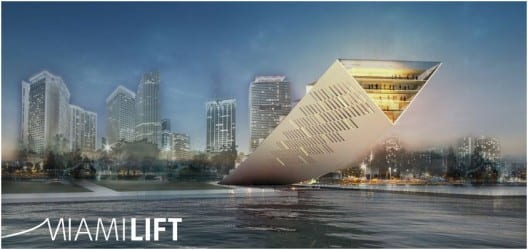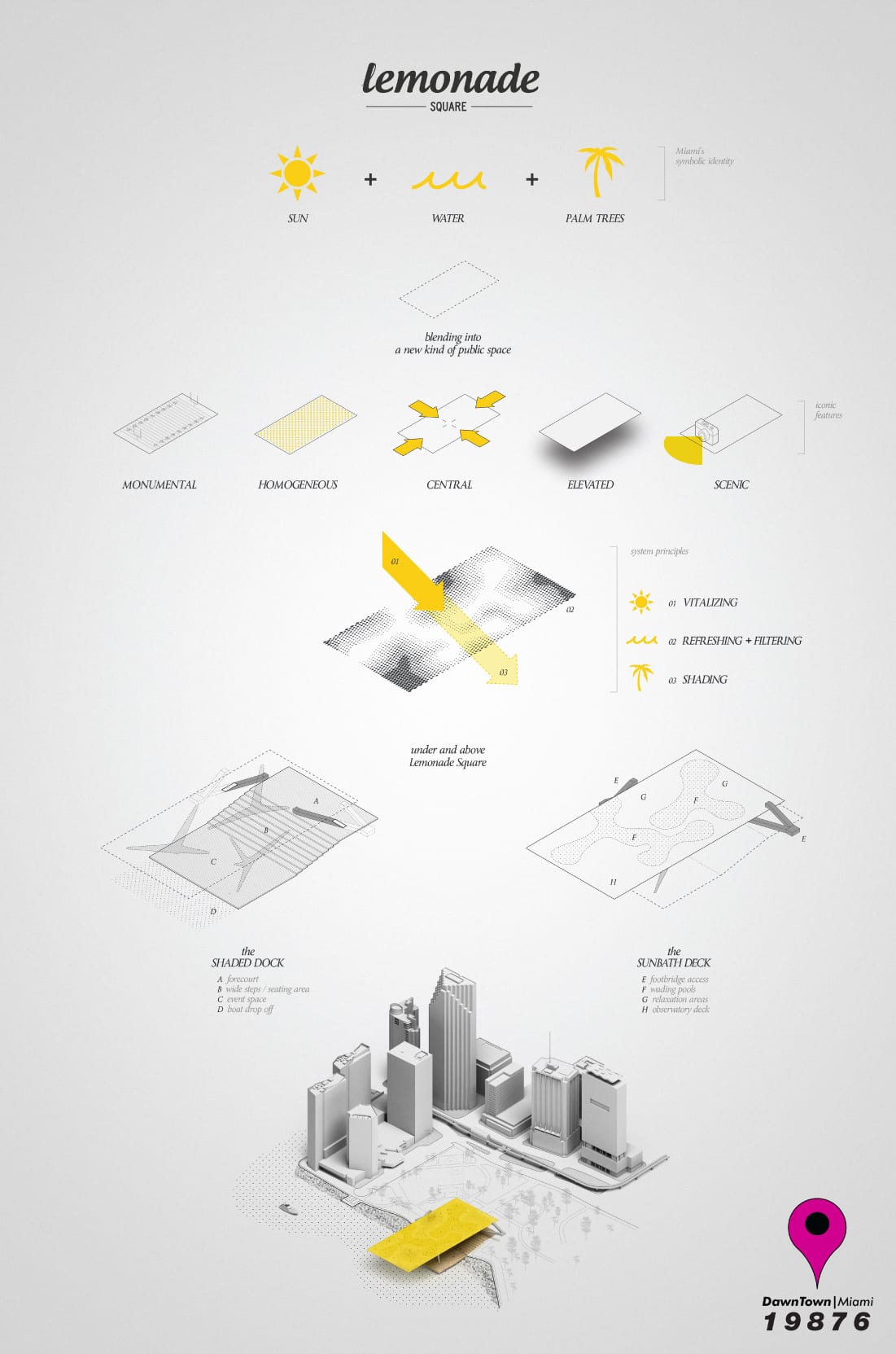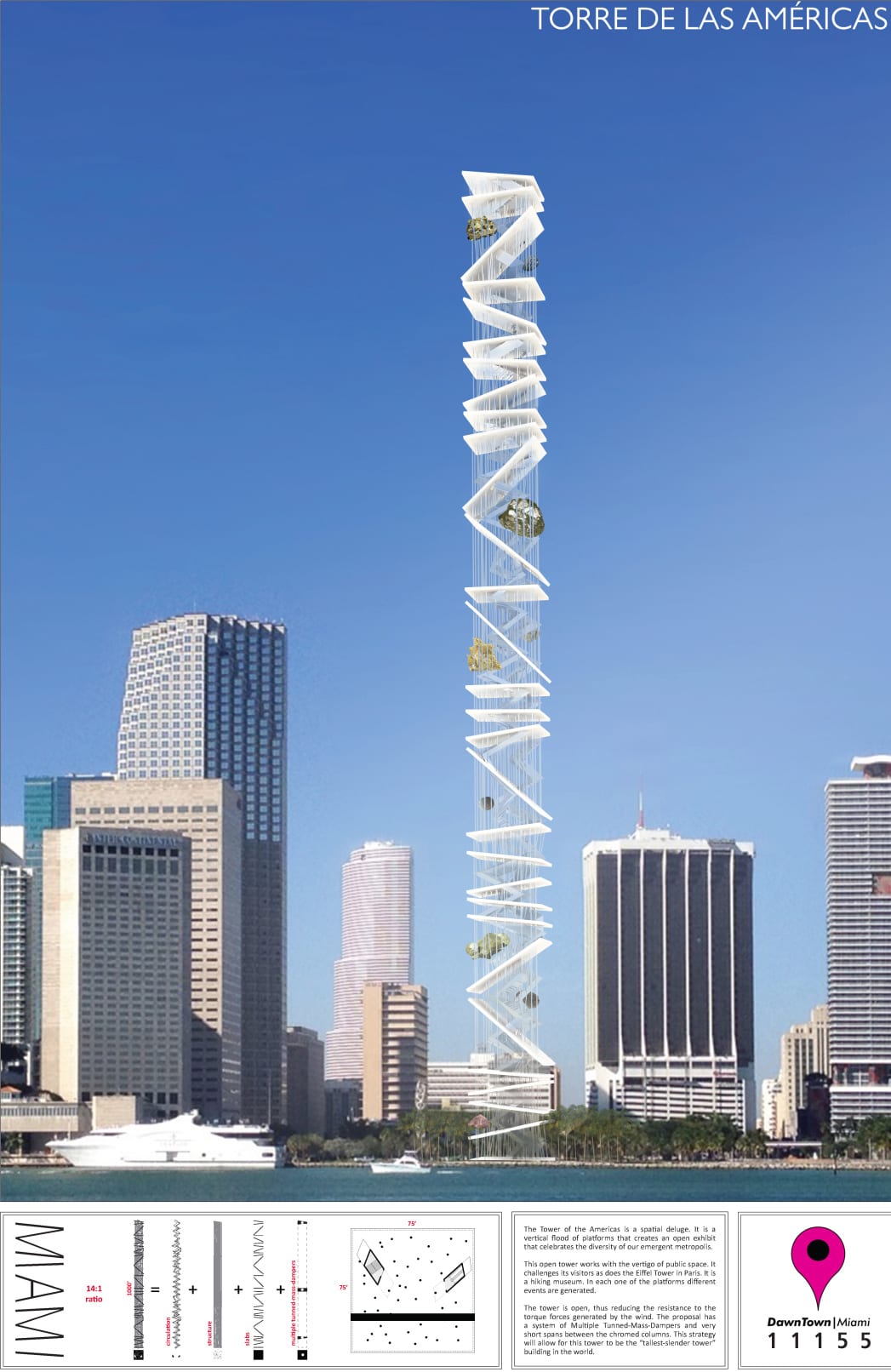
Imagining a design competition for a Miami landmark raises a common question: “Aren’t Miami and Miami Beach actually one big city?” Since both municipalities have their own local administrative institutions and history, focusing exclusively on Miami would suggest that each entity also has its own unique identity and, therefore, its own iconic symbols. Miami Beach has no such identity problem. Ocean Drive with its art deco architecture has long been a recognizable advertising staple for the community. Moreover, a number of its recent modern buildings—Publix Supermarket by Carlos Zapata and Lincoln Road Parking Garage by Herzog de Meuron—have bolstered the city’s image as a place where cutting edge design takes place.
Although the City of Miami has its share of forward-looking modern architecture, it still lacks a visually riveting landmark. The skyscrapers lining the waterfront—prominent on the City’s website—can hardly set it apart from any number of large coastal cities. Still, recent projects such as the Performing Arts Center by Pelli Clarke Pelli, American Airlines Arena and Atlantis by Arquitectonica, and the new Perez Art Museum by Herzog de Meuron have dramatically changed the downtown, most notably along Biscayne Boulevard.
Building on advances in the city’s most recent architectural accomplishments, DawnTown, a local non-profit promoting cutting edge design, launched the LANDMARK MIAMI competition as an instrument to explore symbolic solutions to the city’s visual identity. In the words of the sponsors:
“The competition is centered around the idea of how cities are recognized and perceived through architecture. Many cities worldwide are instantly identified by their exclusive architectural elements: Seattle has the Space Needle, St. Louis has the Arch, Paris the Eiffel Tower, Sydney has it’s Opera House, and the list goes on. This raises the question: What is Miami’s landmark? In the last 10 years, the city has radically changed and continues to do so. What this competition seeks, is not to replace significant architecture, but to add a new landmark representing what Miami is about today and for the future.”
The competition site was Bayfront Park, toward the waterfront where the Noguchi fountain is located. Designers were asked to create a new icon or symbol within the park and overlooking the waters of Biscayne Bay.
The competition jury consisted of:
• Allan Shulman, FAIA, Principal of Shulman+Associates and President of the AIA Miami chapter;
• Damir Sinovcic, Author and Editor of the architectural publication DesignBook; • • Javier Betancourt, Deputy Director of the Miami Downtown Development Authority;
• Joachim Perez, Executive Director of DawnTown
The jury adjudicated the following ranking:
First Place ($3,000)
MIAMI LIFT
Team name: Studio Dror – Dror Benshetrit
Location: New York City
This clever proposal resembles a giant cut-out from the park, cantilevered above the water, which is formed by the intervention in the shoreline. The building also has its functions, not only as an observation deck, but also as a media center, retail and exhibition space. The best views from a distance would be from boats, both offshore and up close, and especially from the air. Aside from some awkward construction issues this proposal might pose, there can be little doubt that its uniqueness won the day with the jury. -Ed
Second Place ($1500)
LEMONADE SQUARE
Team members: David Giraldeau, Alexandre Guilbeault
Location: Montreal, Canada
Team name: REMED
There are a lot of swimming pools along the coastline, but none could match this. Cloaked in a bright yellow, this is a destination for kids who can splash around on the upper level, while some family members can relax below deck. The thin supports provide the structure with a special ethereal quality. -Ed
Third Place ($500)
TORRE DE LAS AMERICAS
Team members: Mauricio Gonzalez, Alfredo Andia
Location: Miami, FL, USA / Santiago, Chile
There had to be a tower in this competition, and this one caught the eyes of the jurors and kept it in contention. Still, Miami has so many high-rises along its coastline, that it would seem redundant to add this to the mix. And what happens during hurricane season? Would anyone be willing to take odds on its survival after a serious blow? -Ed
Honorable Mention
GREAT SPIRIT WOODS
Team members: Jakub Frolik &Â Vojtěch Kolář
Location: Brno, Czech Republic
Team name: Frolík & Kolář + VIZarch.cz
Long iron tubes combined with a pressurized system producing a cool haze are intended to serve as a haven for persons longing to escape the hustle and bustle of the city. This brings to mind Diller and Scofidio’s Blur Building, also located at the water’s edge, which turned out to be a most popular attraction at Expo 2002 in Switzerland. In this case, a little more adventure is probably on the menu — without the need of a raincoat.









































